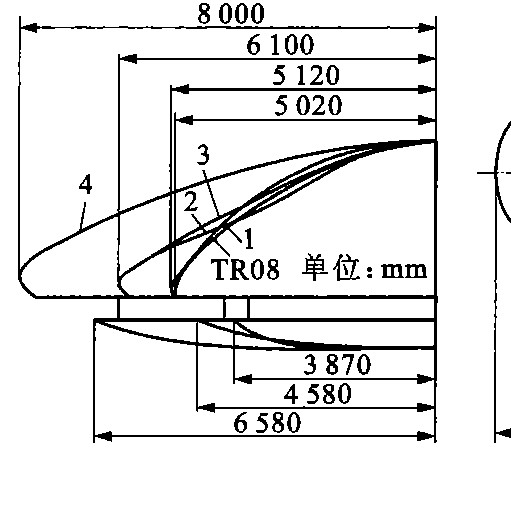Numerical simulation and parameterized investigation of aerodynamic drag performances of high-speed maglev trains
-
摘要: 基于粘性流体力学理论, 按三维可压缩粘性流对具有流线型头部形状的TR08列车以及通过变化流线型头部纵剖面高度或流线型头部长度设计出的4种新头型列车的周围流场进行了数值模拟。为评估不同流线型头部外形的气动阻力性能, 定义了表示其形状特征的整体长细比作为评估依据, 综合考虑了流线型头部水平投影形状和纵向对称面投影形状对气动阻力性能的影响。通过对5种不同头型列车的模拟结果进行对比分析, 得出了流线型头部外形对气动阻力性能影响的规律: 随着流线型头部长度增加, 气动阻力降低, 而中间车阻力变化不大; 在头部流线型长度相当的情况下, 纵剖面轮廓线上凸的头车气动阻力比下凹的小, 而尾车气动阻力大。计算得到的不同流线型列车的整体长细比大小排序与其气动阻力系数排序完全一致。分析结果表明, 增加流线型头部长度是减小气动阻力的有效途径; 整体长细比能较好地反映流线型头部对列车气动阻力性能的影响。Abstract: The flow fields around streamlined high-speed maglev trains, including train TR08 and four new trains designed by changing the profile or length of longitudinal projection, were simulated with 3-D compressible viscous fluid theory. In order to evaluate the aerodynamic drag performances of different nose configurations, a non-dimensional parameter defined as total slenderness ratio, which indicated the configuration features, was brought forward as evaluating criterion, the influences of the horizontal and longitudinal projections of train streamlined noses on the drag performances were taken account. Simulation result shows that when other parameters are same, the aerodynamic drag decreases with the length increase of the streamlined nose, while the drag of middle car varies within a small range, when the length of streamlined nose is almost same, the aerodynamic drag of front car with protruding longitudinal profile is less than that of the concave, while that of the rear car is contrary. The order of total slenderness ratios of the five trains is as same as that of aerodynamic drag coefficients. Investigation result shows that increasing the length of streamlined nose is one of the effective ways to decrease train aerodynamic drag, and the total slenderness ratio can well reflect the streamlined configuration influence on train drag.
-
表 1 5种头型方案的长细比
Table 1. Slenderness ratios of five trains
头型方案 0 1 2 3 4 λH 2.80 2.71 3.60 3.60 4.68 λV 3.69 3.77 5.14 4.88 5.75 λM 2.95 2.89 3.86 3.82 4.86 表 2 λH和λV的变化引起阻力系数的变化
Table 2. Variation effect ofλHandλVon drag coefficient
项目名称 Δλ1 Δλ2 ΔCD 头型1和0对比 Δλ101=λ11-λ10 Δλ201=λ21-λ20 ΔCD01=CD1-CD0 头型2和0对比 Δλ102=λ12-λ10 Δλ202=λ22-λ20 ΔCD02=CD2-CD0 -
[1] 沈志云. 对磁悬浮高速列车技术认识的两个错误观点[J]. 交通运输工程学报, 2004, 4(1): 1-2. doi: 10.3321/j.issn:1671-1637.2004.01.001Shen Zhi-yun. Two wrong viewpoints towards high-speed maglev train[J]. Journal of Traffic and Transportation Engineering, 2004, 4(1): 1-2. (in Chinese) doi: 10.3321/j.issn:1671-1637.2004.01.001 [2] Raghuathan S, Kim H D, Setoguchi T. Aerodynamics of highspeed railway train[J]. Progress in Aerospace Sciences, 2002, 38(6): 469-514. [3] Tyll J, Liu D, Schetz J, et al. Experimental studies of magnetic levitation train aerodynamics[J]. AIAA Journal, 1996, 34(2): 2 465-2 470. [4] 李人宪, 翟婉明. 磁悬浮列车横风稳定性的数值分析[J]. 交通运输工程学报, 2001, 1(1): 99-101. doi: 10.3321/j.issn:1671-1637.2001.01.025Li Ren-xian, Zhai Wan-ming. Numerical analysis of crosswind stability of magnetically levitated trains[J]. Journal of Traffic and Transportation Engineering, 2001, 1(1): 99-101. (in Chinese) doi: 10.3321/j.issn:1671-1637.2001.01.025 [5] 武青海, 俞翰斌, 李和平. 磁悬浮列车空气动力学仿真计算探讨[J]. 铁道机车车辆, 2004, 24(2): 18-20. https://www.cnki.com.cn/Article/CJFDTOTAL-TDJC200402003.htmWu Qing-hai, Yu Han-bin, Li He-ping. A study on numerical simulation of aerodynamics for the maglev train[J]. Railway Locomotive and Car, 2004, 24(2): 18-20. (in Chinese) https://www.cnki.com.cn/Article/CJFDTOTAL-TDJC200402003.htm [6] 梁习锋, 舒信伟. 列车风挡对空气阻力影响的数值模拟研究[J]. 铁道学报, 2003, 25(1): 34-37. https://www.cnki.com.cn/Article/CJFDTOTAL-TDXB200301007.htmLiang Xi-feng, Shu Xin-wei. Numerical simulation research on train aerodynamic drag affected by the train windshield[J]. Journal of the China Railway Society, 2003, 25(1): 34-37. (in Chinese) https://www.cnki.com.cn/Article/CJFDTOTAL-TDXB200301007.htm [7] Kwon H B, Park Y W, Lee D H, et al. Wind tunnel experiments on Korean high-speed trains using various ground simulation techniques[J]. Journal of Wind Engineering and Industrial Aerodynamics, 2001, 89(13): 1179-1195. [8] 梁习锋, 田红旗. 列车气动性能评估参数研究[J]. 中国铁道科学, 2003, 24(1): 38-42. https://www.cnki.com.cn/Article/CJFDTOTAL-ZGTK200301008.htmLiang Xi-feng, Tian Hong-qi. Research on evaluating parameters of train aerodynamic performance[J]. China Railway Science, 2003, 24(1): 38-42. (in Chinese) https://www.cnki.com.cn/Article/CJFDTOTAL-ZGTK200301008.htm -





 下载:
下载:














